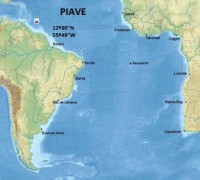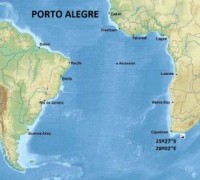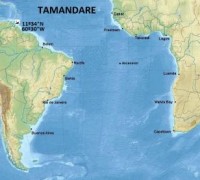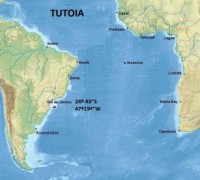SHIPS HIT BRAZIL 33 - BRAZILIAN SHIPS LOST
32)TAUBATÉ (ATTACKED BY LUFTWAFFE)
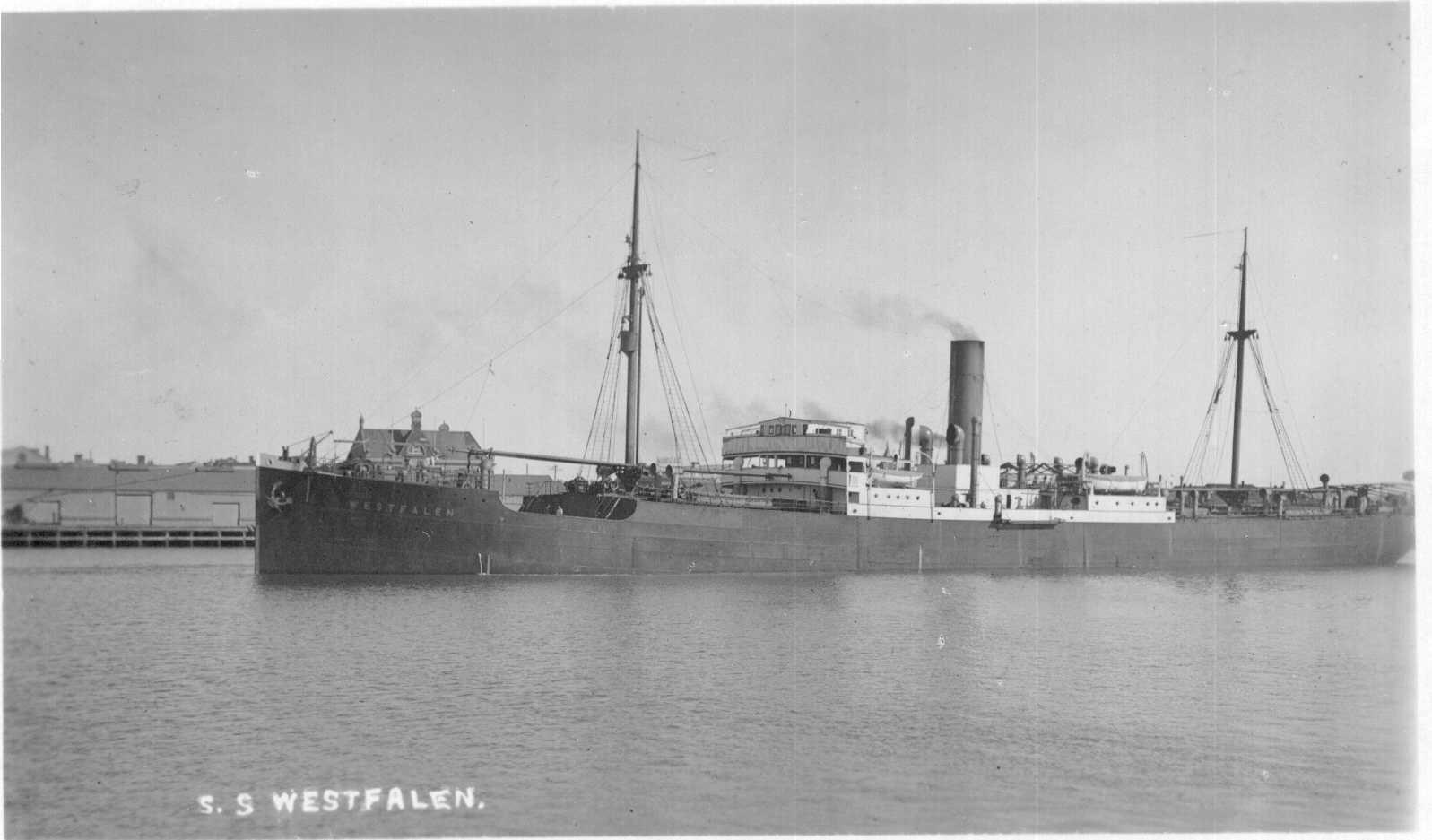
Above sister ship Westfalen. Photo http://passengersinhistory.sa.gov.au/file/24476
TAUBATÉ. THE FIRST BRAZILIAN SHIP ATTACKED BY GERMANS
The Taubaté was an old ship, built in 1905 by the German shipyard Bremer Vulkan AG, of the city of Bremen. It initially bears the name of Franken, who baptized a class of nine freighter ships and this ship belonged initially to the shipping company Norddeutscher Lloyd. These ships basically covered the routes between Germany and Australia, as well as South America.
Both the Franken and her sister ships were equipped with a steam engine of 3,200 HP, which gave it the maximum speed of 11.5 knots (about 21 kilometers ), with 130 meters length and 16 meters beam, displacing 5,055 tons.
In 1917 with the deterioration of diplomatic relations between Brazil and Germany the ships of this nation in our ports were confiscated by our government, being renamed and handed over to national shipping companies. Franken received the name of Taubaté, and was under the responsibility of the company Lloyd Brasileiro. Soon she was sailing with a load of coffee to India. Since 1917 this ship had been bearing our green and yellow flag and fulfilling its role of transporting cargo by the seas
At the end of the 1940 Taubaté was captained by experienced long-time Mario Fonseca Tinoco, a man who had a long and respectable career, but perhaps for his political positions and a problem occurred when he was in charge of one of Lloyd's boats Brazilian, was almost always assigned to command old and small ships.
In November of that year the old ship was hired by an export company from Rio de Janeiro to carry a load of 3,000 tons of coffee, packed in 110,000 bags, to the belligerent area of the Mediterranean Sea. This cargo was previously loaded at the port of Santos and they departed from the port of Rio on November 14. As a precautionary measure, two large Brazilian flags were painted on both sides of Taubaté to identify the nation to which the ship belonged.
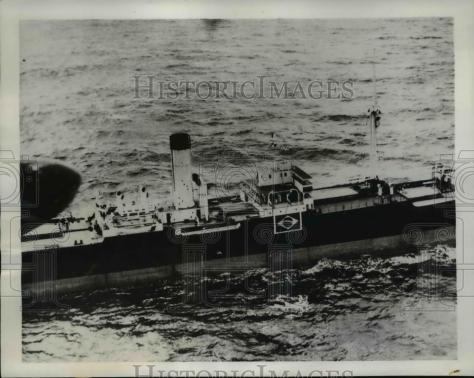
As she was bound to the Mediterranean Sea and wishing to avoid problems, the Lloyd Brasileiro ordered Captain Mario Fonseca Tinoco to cross the South Atlantic to the Cape of Good Hope in South Africa to get around this dangerous maritime area and enter the Indian Ocean. Hence he was to accompany the East African coast to the Gulf of Aden, between the present countries of Yemen and Djibouti. From there Taubaté would enter the Red Sea and follow it to the Suez Canal, overtaking it to navigate the Mediterranean Sea and reach Port Said in Egypt, her final destination.
After emptying all the coffee Taubaté remained at Port Said waiting for the next cargo, more than forty days have passed since the arrival of Taubaté in that port. It is when the companies Société de d'Avances Commerciales of Egypt and the Shalon Brothers of Isaac Shalon, a Jew settled in Turkey arrive at scene.
Both companies have entered into an agreement with Lloyd Brasileiro's representative, perhaps Captain Tinoco himself, to charter the Egyptian port of Alexandria to the port of Boston, United States. But before that, the ship would have to pick up cargo at ports on Cyprus and more cargo at Port Sudan, the main Sudanese seaport, on the shores of the Red Sea. In the sequence there would be stops in the ports of Buenos Aires, Montevideo, Santos, Rio de Janeiro, New York, Baltimore and finally Boston. The insurance of the crew was in charge of the foreign contractors.
This kind of chartering had nothing wrong with it, the problem was to traverse the distance between Egypt and Cyprus, an extremely strategic island and British colony in the Mediterranean. Even though it was only 200 nautical miles (360 km), almost nothing in terms of sea distances, what was happening around Cyprus at the time was the source of concerns.
The Brazilian ship departed and, according to the newspapers, anchored in the Cypriot ports of Limassol, Lanarca and finally Famagusta. After collecting cargoes, Taubaté sailed from the island of Cyprus to Egypt on the morning of February 22, 1941.
From Famagusta, the cargo inspector José Francisco Fraga, 28, who lived in Rio de Janeiro, wrote a letter to his family where he commented that they "did not expect news of him soon ". He had no idea how tragically right he was!
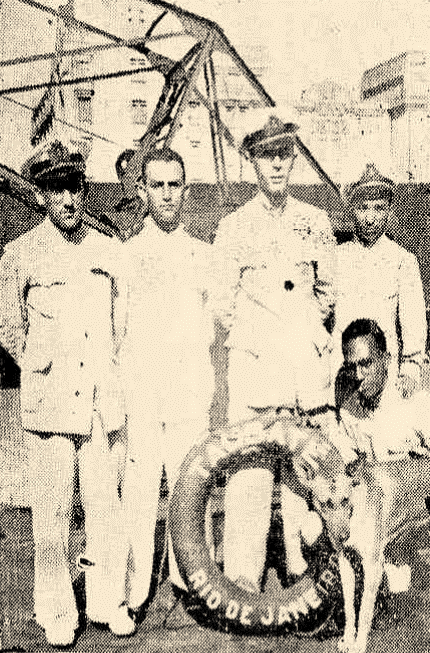
Fraga is seen far left.
On 21 February the Luftwaffe attacked the Convoy AS.21, which was escorted by three destroyers from the port of Piraeus, Greece, to Alexandria, Egypt. It all started with three JU 88 A 4s that fell upon the thirteen ships of the convoy as they sailed on the channel of the island of Kythira, just off the southern end of the Peloponnese region, the southern part of the continental portion of Greece. The JU 88 hit the Danish tanker, Marie maersk, of 8,271 tons, but working for the British. She was towed to the port of Piraeus severely damaged, with six crewmen dead, eight missing and four who were captured.
After dawn on 22 March, fifteen German aircraft again attacked the Convoy AS.21, this time 22 nautical miles (35 kilometers) south of the island of Gavdos, a small promontory considered one of the most extreme points in Europe, the few miles south of the island of Crete. This time it was a joint action of bombers Ju 88 A 4 and HE 111 H 3 that launched several bombs and sank the Greek merchant Embiricos Nicolaos (3,798 tons) and the Norwegian tanker Solheim (8,070 tons)
While all this took place, almost 500 nautical miles east of there (about 930 km), around 5 o'clock in the morning of this intense 22 March, Taubaté left the island of Cyprus.
DIE WALKÜRE
Without more data it is impossible to point out if it was a Ju 88 A 4 or a German HE 111 H 3 that attacked the Brazilian ship, as well as we do not know where it left and neither of which squadron was part. However, I believe the action taken early in the morning against convoy AS.21, south of Gavdos Island, may have caused other Nazi bombers to continue to fetch the convoy for a new attack. As convoy AS.21 ships attempted to reach Alexandria, the same fate of Taubaté, it is not difficult to suppose that some of these aircraft reached the area south of Cyprus and there was the encounter with the Brazilian ship.
Conjectures aside all the information indicates that around noon, with the sun in its peak, when the ship was about 100 nautical miles from Lanarca, appeared a twin-engine airplane flying slow, low and sporting the unmistakable swastika Nazi in the tail, as well as swastika crosses on the sides and wings. These Teutonic aviators did not come to the sound of Richard Wagner's Third Act of the Opera Die Walküre, but to the sound of powerful Jumo engines
The aircraft passed over Taubaté and began to make turns. The crew was surprised, but calm, for at the sides the Brazilian flag was clearly painted and Brazil still had diplomatic relations with Nazi Germany. However, soon after a few laps the German plane began to turn directly to the ship and came at high speed, that's when the first of six (some sources point to four) bombs were dropped and a water fountain emerged from the sea. Immediately after the fall of the first bomb began the bursts of machine guns.
Captain Mario Fonseca Tinoco said that at first there was panic on board. Certainly at that time the people who were not on the deck, perhaps for fear of a bomb hitting the hull and the ship sinking rapidly, came out of the ship. It may be that at this moment the Brazilian João Lins has seen the attacking airplane.
Captain Tinoco told a newspaper in Recife that after the first bomb dropped, his idea was to keep a steady course of the boat, always ahead. I do not know if this was the best tactic against this type of attack, but in the case of Taubaté it worked.
The captain tried to send all sorts of signals to the plane, but the response was more shootings. The Nazi plane returned and one of the bombs fell very close to the Brazilian ship, shuddering everything on board, breaking the hull of the vessel with shrapnel, injuring crewmen and damaging the rudder, which became inoperative. Telegraphers Américo Rodrigues da Silva, Josias Correia de Castro and Raimundo Evangelista Monteiro radioed telegraphic messages about the attack, but the station was hit several times and one crewmember was wounded.
Captain Tinoco ordered them to hoist a white flag, but nothing seemed to have moved the Germans from their attitude. He also told the Rio Newspaper that some bombs were painted in black and one in red. Crew members commented that the plane was going very low, "close to the telegraph antennas" and it called attention of the Brazilians the insistence of the Germans to shoot with their machine guns against the ship and the crew. Certainly those airmen wanted to paint the Taubaté silhouette on the tail of their aircraft, indicating their sinking.
As the plane dropped bombs and bullets, crew members were injured. The 2nd cook Teodoro da Silva Ramos, took several shrapnel in the back, causing wounds that would leave great scars. Another seriously injured was Henrique Leandro da Silva, a colleague of the João Lins Filho, who had a fractured skull. The driver Aníbal Landelino Borges took such injuries, with such gravity, that nobody on board believed in his survival. It was the valiant work of the nurse Emiliano Primo da Silva who saved his life and of another twelve wounded.
The cargo inspector Francisco Fraga was the first Brazilian to perish as a result of direct enemy action during World War II. Without the rudder Taubaté then stopped, which left him completely ready to be sunk. At this point the narratives are conflicting, but either because the plane's bomb load had ended, or because of aviators' inability to hit Taubaté.
Even so, the captain gave orders to leave the ship, but the bomber's crew continued firing at the ship, frustrating the sailors' attempts to escape and also hitting or "chopping" lifeboats. It was at this moment that the stoker João Pereira da Silva, who was holding one of the ropes used to lower one of the ship's lifeboats, was hit by a hail of shrapnel, fell on the deck and collapsed.
The rigging, the funnel, the hull, the deck, the bridge, the captain's cabin, the radiotelegraphy room were riiddled with gunfire. The machine guns of the plane swept the deck from stern to bow. The border mascot, a dog named Taubaté, was injured twice, but survived.
The Chief Officer Armando Viana commented to the Diário de Pernambuco that the attack only stopped when another airplane appeared on the horizon. Some of the crew were frightened by the new "visitor," but the Nazi bomber disappeared "as if by charm" because the new aircraft was English. For him it was a "Spitfire", but official documents of the Admiralty, indicate that the salvage aircraft was a seaplane. Reports say that the attack of the German airplane lasted, depending on the source, from 60 to 90 minutes.
NEWS IN BRAZIL
Taubaté was able to reach Alexandria, where the steamship Juazeiro was moored, which gave support to the personnel of the attacked ship, as well as the Brazilian consular authorities of Cairo, the British and Egyptian authorities. Amidst a lot of bullet holes, pieces of shrapnel and blood, the crew was removed to the hospital.
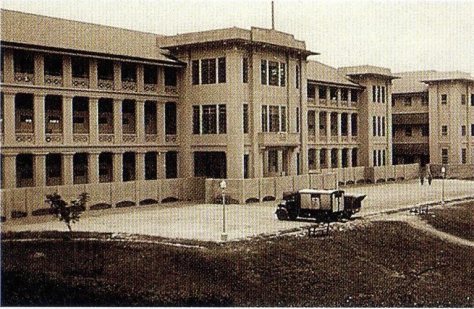
Above de British Military Hospital at Alexandria. Photo. http://www.mycommunity.org.sg/heritage/mei-ling-alexandra-trail/48-alexandra-hospital-24.html
The cargo inspector José Francisco Fraga was buried in a simbolic ceremony, but with much emotion, in the Christian Cemetery of Alexandria. He died the day before turning 29 and left in Rio the bride Geraldina Gonçalves with the ready-to-marry trousseaus that would take place upon his return. But the dream was broken.
For the coming days the dictator Getulio Vargas and his Ministers, together with Lloyd Brasileiro, they promise to support families and especially to meet Dona Isabel Maria Fraga's request to bring Fraga's corpse to be buried in Rio. Another situation involving Ms. Isabel was that she told the press that she did not sleep properly the night of March 22 and dreamed of her son wearing his immaculate white uniform of the Merchant Navy, but this one was stained with blood.
The Itamaraty issued a note of protest to Nazi Germany, whose chancellery responded about eight days later informing it would investigate the case and punish those who had made mistakes. But that's all.
SLOW AND COMPLICATED RETURN
Merchant Taubaté and her crew stayed 47 days in Egypt, where repairs were made and the wounded crew gradually recovered. It was classified as a true miracle that there was a single death due to the air raid. On March 25 the stoker João Pereira da Silva is operated by skilled doctors and English nurses of B.M.H. Alexandria (British Military Hospital Alexandria). These professionals remove from their body four shrapnel projectiles of machine gun of the frontal region and two shrapnel in his arm. The stoker lost all the teeth in his upper arch.
During this period the Taubaté crew witnessed some German air raids, both day and night, as well as the British defensive action with the use of anti-aircraft guns. Luckily the ship was not hit.
PORT OF ALEXANDRIA EGYPT
Finally the day of departure has arrived. The ship was heavily loaded with Egyptian cotton, leathers, wool, arabic gum and other smaller cargoes. He headed south along the east coast of Africa, retracing his previous route. There were stopovers in Port Sudan, Aden and Lourenço Marques, capital of the then Portuguese East African territory (present Maputo, capital of Mozambique).
In this city the Portuguese colonial authorities held such a welcoming reception that Captain Tinoco considered it a true "homage". It was probably at this port that the captain realized that his crew needed a break. They had been away from home for several months and went through troublesome problems, seeing some injured comrades and one dead in the midst of an unusual situation. The captain then decided to redo the script and sail to Recife. The crew would be replaced there before going to the United States.
But before that, there was a stop at the port of East London, south-east coast of South Africa. Quick stop, but on returning to the high seas towards Brazil Taubaté was hit by a violent storm, which in the thoughts of the Chief Officer Armando Viana "She just did not go to the bottom because was loaded." But this storm marked the crew already hit, since one of its members was simply thrown overboard and disappeared.
The Taubaté then goes to the capital of Pernambuco crossing the Atlantic Ocean with its weakened machines, achieving ridiculous four knots of speed. It took more than a month to get this done. On entering the port at five o'clock on August 13, 1941, the ship's condition was such that it was only with the support of the tug October 4 that it entered the port.
AT RECIFE HARBOR
A true crowd of locals go to the docks to witness the arrival of Taubaté, which anchored in Warehouse 5, where the port authorities, the press and even some relatives of the cook Teodoro da Silva Ramos waited anxiously to visit the 2nd wounded. It drew attention to all the holes of the projectiles and shrapnel in various places of the boat. When they disembarked, one of the crew showed the press a box full of shrapnel that hit the Taubaté.
After the repairs Taubaté returned to commercial shipping activities in the middle of World War II. Documents indicate that this ship participated in several convoys between Brazil and the island of Trinidad, or from New York to Guantánamo, Cuba, and from there to the Panama Canal area. In August 1944, as we can see in this US Navy document, Taubaté even commanded one of these convoys.
By Rostand Medeiros - Effective Member of the Historical and Geographical Institute of Rio Grande do Norte - IHGRN
